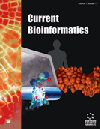- Home
- A-Z Publications
- Current Bioinformatics
- Previous Issues
- Volume 17, Issue 2, 2022
Current Bioinformatics - Volume 17, Issue 2, 2022
Volume 17, Issue 2, 2022
-
-
CRISPR/ Cas9 Off-targets: Computational Analysis of Causes, Prediction, Detection, and Overcoming Strategies
More LessAuthors: Roshan K. Roy, Ipsita Debashree, Sonal Srivastava, Narayan Rishi and Ashish SrivastavaCRISPR/Cas9 technology is a highly flexible RNA-guided endonuclease (RGEN) based gene-editing tool that has transformed the field of genomics, gene therapy, and genome/ epigenome imaging. Its wide range of applications provides immense scope for understanding as well as manipulating genetic/epigenetic elements. However, the RGEN is prone to off-target mutagenesis that leads to deleterious effects. This review details Read More
-
-
-
A Novel Feature Selection Method Based on MRMR and Enhanced Flower Pollination Algorithm for High Dimensional Biomedical Data
More LessAuthors: Chaokun Yan, Mengyuan Li, Jingjing Ma, Yi Liao, Huimin Luo, Jianlin Wang and Junwei LuoBackground: The massive amount of biomedical data accumulated in the past decades can be utilized for diagnosing disease. Objective: However, the high dimensionality, small sample sizes, and irrelevant features of data often have a negative influence on the accuracy and speed of disease prediction. Some existing machine learning models cannot capture the patterns on these datasets accurately without utilizing feature se Read More
-
-
-
Heterogeneous Gene Expression Cross-Evaluation of Robust Biomarkers Using Machine Learning Techniques Applied to Lung Cancer
More LessBackground: Nowadays, gene expression analysis is one of the most promising pillars for understanding and uncovering the mechanisms underlying the development and spread of cancer. In this sense, Next Generation Sequencing technologies, such as RNA-Seq, are currently leading the market due to their precision and cost. Nevertheless, there is still an enormous amount of non-analyzed data obtained from older te Read More
-
-
-
Cervical Cancer Metastasis and Recurrence Risk Prediction Based on Deep Convolutional Neural Network
More LessAuthors: Zixuan Ye, Yunxiang Zhang, Yuebin Liang, Jidong Lang, Xiaoli Zhang, Guoliang Zang, Dawei Yuan, Geng Tian, Mansheng Xiao and Jialiang YangBackground: Evaluating the risk of metastasis and recurrence of a cervical cancer patient is critical for appropriate adjuvant therapy. However, current risk assessment models usually involve the testing of tens to thousands of genes from patients’ tissue samples, which is expensive and timeconsuming. Therefore, computer-aided diagnosis and prognosis prediction based on Hematoxylin and Eosin (H) pathological images Read More
-
-
-
TP-MV: Therapeutic Peptides Prediction by Multi-view Learning
More LessAuthors: Ke Yan, Hongwu Lv, Jie Wen, Yichen Guo and Bin LiuBackground: Therapeutic peptide prediction is critical for drug development and therapy. Researchers have been studying this essential task, developing several computational methods to identify different therapeutic peptide types. Objective: Most predictors are the specific methods for certain peptides. Currently, developing methods to predict the presence of multiple peptides remains a challenging problem. Moreover, Read More
-
-
-
iAnt: Combination of Convolutional Neural Network and Random Forest Models Using PSSM and BERT Features to Identify Antioxidant Proteins
More LessAuthors: Hoang V. Tran and Quang H. NguyenBackground: Reactive Oxygen Species (ROS) play many roles in the body, such as cell signaling, homeostasis, or protection from harmful bacteria. However, an excess of ROS in the body will damage lipids, proteins, and DNA. Many studies have shown that various environmental factors increase the amount of ROS produced in the body. Antioxidant proteins are responsible for neutralizing these ROS or free radicals. Although the a Read More
-
-
-
Immune-related Gene-based Prognostic Signature for the Risk Stratification Analysis of Breast Cancer
More LessAuthors: Dongqing Su, Qianzi Lu, Yi Pan, Yao Yu, Shiyuan Wang, Yongchun Zuo and Lei YangBackground: Breast cancer has plagued women for many years and caused many deaths around the world. Methods: In this study, based on the weighted correlation network analysis, univariate Cox regression analysis, and least absolute shrinkage and selection operator, 12 immune-related genes were selected to construct the risk score for breast cancer patients. The multivariable Cox regression analysis, gene set enrichme Read More
-
-
-
Identification of Key Histone Modifications and Hub Genes for Colorectal Cancer Metastasis
More LessAuthors: Yuan-Yuan Zhai, Qian-Zhong Li, Ying-Li Chen and Lu-Qiang ZhangBackground: Epithelial-Mesenchymal Transition (EMT) and its reverse Mesenchymal- Epithelial Transition (MET) are essential for tumor cells metastasis. However, the effect of epigenetic modifications on this transition is unclear. Objective: We aimed to explore the key histone modifications and hub genes of EMT/MET during Colorectal Cancer (CRC) metastasis. Methods: The differentially expressed genes and di Read More
-
Volumes & issues
-
Volume 20 (2025)
-
Volume 19 (2024)
-
Volume 18 (2023)
-
Volume 17 (2022)
-
Volume 16 (2021)
-
Volume 15 (2020)
-
Volume 14 (2019)
-
Volume 13 (2018)
-
Volume 12 (2017)
-
Volume 11 (2016)
-
Volume 10 (2015)
-
Volume 9 (2014)
-
Volume 8 (2013)
-
Volume 7 (2012)
-
Volume 6 (2011)
-
Volume 5 (2010)
-
Volume 4 (2009)
-
Volume 3 (2008)
-
Volume 2 (2007)
-
Volume 1 (2006)
Most Read This Month
Article
content/journals/cbio
Journal
10
5
false
en


